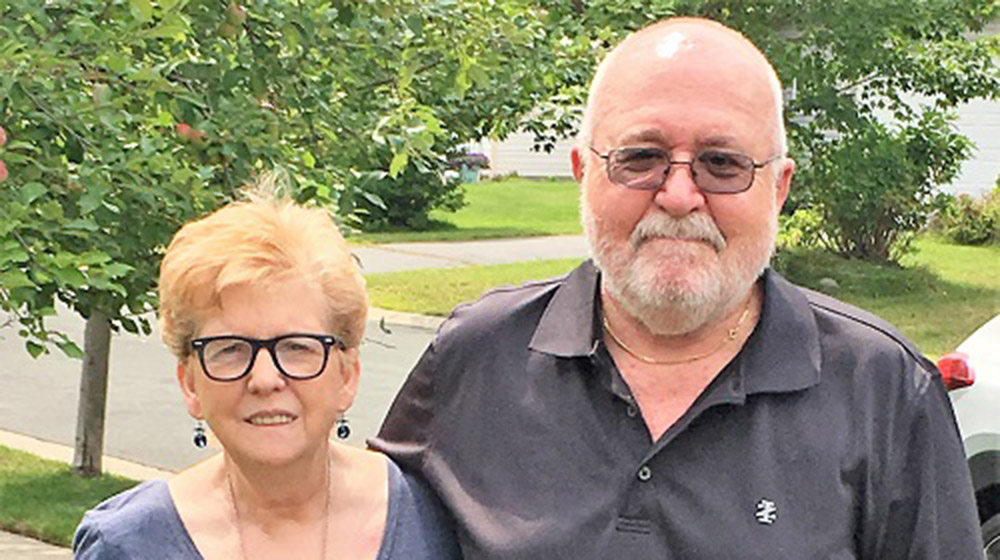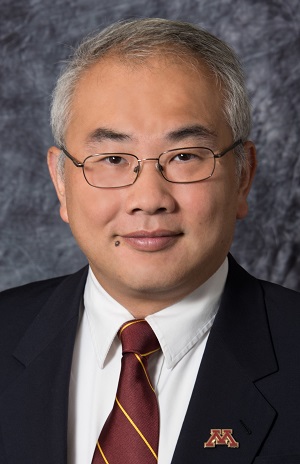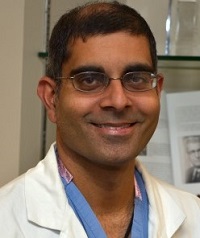U of M Neurosurgery Department team worked together to transform a patient’s life

Persistence. Humility. Teamwork.
These three qualities helped Plymouth, MN, resident Ralph Watschke survive what was thought to be an inoperable brain tumor.
Persistence.
Ralph (pictured at right with his wife, Anne) had a persistent advocate by his side in his wife, Anne. “You need to have someone like my wife be your advocate; however, she has an exclusive contract with me,” he quipped.
Over time, Anne thought that Ralph was showing signs of dementia, such as forgetfulness, difficulty with speaking, and lethargy. She talked to several doctors about his condition, but it wasn’t until they went to the Minneapolis Veteran’s Affairs Medical Center that she felt they made any headway.
“The VA tested Ralph immediately and determined that he needed to see a neuropsychologist, who believed Ralph had frontotemporal lobe dementia,” said Anne. An MRI was required with this diagnosis. Within an hour of the imaging, the doctor returned and told Anne and Ralph that he didn’t have dementia…Ralph had a sizeable brain tumor in his frontal lobe.
While Anne and Ralph were somewhat relieved – “Our lives would have been vastly different today if it had been dementia,” she said – they were told the tumor was inoperable. “The neurosurgeons that we consulted wouldn’t touch it because the tumor, which was baseball-sized, had lots of blood vessels associated with it,” Anne explained.
It was then that Ralph was referred to U of M Neurosurgery Department Head Clark C. Chen, MD, PhD, who has significant experience with such brain tumors.
Humility.

Clark Chen, MD, PhD
Considering that Ralph’s tumor was embedded in a maze of blood vessels, Chen engaged his colleague, Ramu Tummala, MD, in managing Ralph’s care. Tummala specializes in treating diseases involving blood vessels of the brain. “As neurosurgeons, we should be humble enough to know that we bring a specific perspective to our patients’ care,” said Chen. “The beauty of being at the university is that these perspectives can be synthesized into a cogent plan that offers the most optimal care for our patients – as it did in this case.”
Tummala performed an angiogram on Ralph, during which a catheter was inserted through a blood vessel in the groin and navigated into the brain. He was impressed by the intimate and complex relationship between the various blood vessels and the patient’s tumor. “Some of the vessels came from outside the brain,” he explained. “The tumor was also supplied by the brain’s own blood vessels, which the tumor had recruited and parasitized.”
Teamwork.
Tummala’s goal was to embolize – or block – many of those blood vessels to minimize risk of blood loss during surgery. It was important for him to have a good dialogue with Chen before the embolization procedure. “You must know what parts of the tumor removal will be straightforward for the surgeon and what parts may create challenges,” Tummala said. “It guides your strategy regarding what areas of the tumor to embolize. You also must take the patient’s health into account. If patients are anemic, for example, they can’t tolerate a lot of blood loss during the tumor surgery, so you want to embolize more aggressively.”

Ramachandra Tummala, MD
Tummala filled preselected blood vessels with embolic glue to stop the blood flow and minimize the risk of bleeding. It was critical that he and his team maintain a precise balance during the embolization procedure. “Left-sided blindness was a serious risk if our glue ended up going into the arterial branches that supply the eye,” he explained (Ralph’s tumor was on the left side). “If you’re too conservative, the surgeon is left to deal with the bleeding, which could harm the patient. If you get overzealous and embolize too much, you can prevent the scalp from healing because you wiped out its blood supply.”
Ralph did very well after the embolization, which was followed by surgical removal of the tumor. “Dr. Tummala and his team shut off the tumor’s blood supply, which allowed me to do the surgery with minimal blood loss,” said Chen. “In fact, the loss was no more than that of a typical surgery.”
Chen added that the tumor resection was, “picture perfect. Surgery is not about dealing with crises as they arise during the procedure, though this is the situation that we sometimes face. Great surgeons anticipate problems beforehand and make sure there are no crises during the actual procedure.”
Outcome.
The two-step process – embolization and surgery – transformed Ralph. “The day after the surgery, he was talking to us like he did ten years ago,” said Anne. “His mind was back completely. He also had a sense of humor again…it was remarkable. There are people where we live who just sat in the hospital with their mouths open when they came to visit. They were flabbergasted by how articulate he was. And all his fine motor skills came back.”
“Both doctors were very calm,” said Ralph, adding, “their demeanor kept me from panicking.”
While Chen celebrates Ralph’s transformation, he remains philosophical about the overall state of medicine today. “It’s difficult for patients to hear they have a condition that physicians cannot treat,” he noted. “Medicine as it exists today is such that you comfort always and cure rarely. Our mission here at the U of M is to get to the stage where we comfort always and cure frequently. With dedicated research on the treatments of tomorrow and genuine partnership between physicians and researchers, we’ll get there.”



